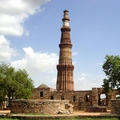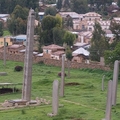Destinations / The Most Famous Towers in the World / The Minaret of Jam
The Minaret of Jam
Let us know Afghanistan - a mountainous country, for centuries it was the object of attack of many invaders, beginning with the antlered Iskander (Alexander of Macedon, in the XI. Before the Hijrah ( IV century BC) and ending with the Soviet and American occupation (XV century ; end of the beginning of the twentieth century XXI ) it was the country Islam - the religion of the overwhelming majority of residents from the time of the Great Arab conquests. Afghanistan was an outpost of Islam, the border fortress, and later a base for the Spread of Islam in India. This is a great period in Afghanistan's history devoted to a masterpiece of the Islamic architecture - the Minaret of Jam.
Location
The Minaret of Jam is situated at the heart of Afghanistan, at about 215 km east of Herat, in the heart of the mountainous province of Gur, at an altitude of 1904 m above the sea level, at the confluence of the Harirud river and its tributary Dzhamrud. They meet three valleys and surrounding mountains reach a height of 2300 m. It is a mountainous region with harsh snowy winters, severe spring floods, the hot and dry summers are not of strategic interest, so it had passed the devastating wars of the last centuries. And once there ran one of the most important trade routes which connected Istanbul (Constantinople then) with India through Tabriz, Ray, Jurjan, Nishapur, Herat, Kabul and Multan. In 1423 AH (2002) Minaret of Jam and its surrounding ruins were listed in the World Heritage List of UNESCO. Jam is believed to have been located in Firuzkuh – the first capital, and then, after the conquest of Herat, the summer residence of the rulers of the Ghurid that ruled Afghanistan and parts of northern India, from Kashgar to the Persian Gulf, in the XII-XIII centuries. The complex of buildings, protected by UNESCO, also includes the ruins of the palace, fortifications, and the Jewish cemetery (XII century.)
Situated nearby
The remains of fortresses and Ghurid towers are on the Harirud river bank, north of the minaret, high on the cliff. There are also remains of the fortifications in the east of the minaret, which create the impression that the minaret was not surrounded by a settlement and a military camp. In this case, the minaret is not only playing the role of a sacred place the call to prayer, but it is also a watchtower. However, the exact location of Firuzkuh still remains a mystery, and conventional sources are unlikely to help, since most of the Arab geographers lived before the city was founded, and the geographers of later periods which put Firuzkuh between Herat and Ghazni wrote nothing about the Ghost town. So we are not sure whether Firuzkuh was in the area. Jam is one of the more than 60 minarets, dating from the beginning of the IV-VI VH (XI - XIII-mid th century.) It is still standing in Afghanistan, Iran and Central Asian Republics. There was a special flavor to the minarets of this period, explained by the fact that they were symbols of the triumph of Islam throughout the region. Some of these towers were built in the mosques, which did not spare the time and conquerors. Other towers, however, were conceived as independent, and also served as a reference for wiring caravans, or watch towers during the war. The most striking representative of this latter type is undoubtedly the Minaret of Jam. Scientists theorize that because of the usefulness of the minaret as a guard tower, the Mongols spared it, destroying the Firuzkuh city in 619 AH (1222).
Description
The Minaret of Jam reminds of the minaret built by Masud III (477-492 AH (1099-1114.)) in Ghazni, which served as a model for builders. Jam is the second highest brick tower in the world after the minaret of Qutub Minar in Delhi. According to some sources, the builders of Qutub Minar used the minaret of Jam as a model. The minaret was apparently built during the reign of Ghiyath al-Din (541-581 AH (1163 and 1203's.) under the sultan of the dynasty Ghurid. The inscription on the minaret construction gives the date of 572 AH (1194). It is likely that the minaret was built in honor of the victory at New Delhi in 570 AH (1192) over the Ghaznavid empire and the Ghurid predecessors who held Afghanistan. Hence, the second name Minaret of Jam is the Tower of Victory. Made entirely of brick, bound with lime mortar, the minaret is 60.41 meters high and consists of octagonal plinth, above which the three truncated cones rise, separated by balconies and topped with a lantern. The original entrance, which is under the alluvial deposits at a depth of approximately 4 m, is currently unavailable. To log in the minaret is possible through a narrow window, leading to a spiral staircase, on which you can climb up to the balcony of the second cone, at about 40 meters high. The narrow upper cone is empty inside. Until now the lantern of the minarets is impossible to reach. The outer surface is covered with a complex decoration minaret in the form of reliefs and bas-reliefs. The upper cone has three epigraphic groups - one under the dome and two below the second balcony - where the inscription is. This shahada, Quranic verses from Surah Al-Saff and the name of "Giyas ad-Din." The lower cone is decorated with eight vertical panels of turquoise glazed tiles, which is the only color stain on the brick surface. The inscription is a quote from the Quran (Surah Maryam, Quran 19), made Kufic writing, and filled with interweaving geometric designs. There is also an eight-point star initial input. The markings are located on the east panel, where the name of the architect was given, Ali ibn Ibrahim of Nishapur. These stylized inscriptions are a striking connection of vertical bars and rounded lines reminiscent of a geometric floral pattern. Opening and saving It's hard to believe, but after the destruction of Firuzkuha the existence of this magnificent minaret was forgotton to the whole external world for eight centuries.
Architectural wonder
Minaret remained unknown outside Afghanistan to its "second opening" during the Russian-Afghan Boundary Commission in 1307 AH (1886). But because it was a territory detached under colonial control of the Russian Empire, the Jama European historians and researchers have not learned its "third opening". The first official mention of its existence was made in 1365 AH (1944), when Ahmed Ali Koazad, the president of the Afghan Historical Society, published in the journal “Anis”, an article about a conversation with His Excellency Abdullah Khan Malekyarom, Governor of Herat, informing him of the Minaret of Jam. He was the first who discovered and photographed it back in 1364 AH (1943). After the minaret was discovered in 1365 AH (1944), he again "lost sight of it." In subsequent years, many expeditions tried to find him, but they have not been successful due to the fact that the territory was a vast, rugged terrain. Only on August 19, 1378 AH (1957) the French archaeologist Andre Maric finally found a minaret, and in 1379 AH (1958) he published their discovery in the "Memoirs of the French delegation in Afghanistan." In 1381 AH(1960), two representatives of the DAFA (the French Archaeological Delegation in Afghanistan), Les Baer and his assistant marshals photographed the decorative panels and conducted an initial, very superficial study of its architectural structure, finding an entrance with two spiral staircases at about 4 m below the present level. This discovery caused a sensation in science. It remains a mystery, as in the area is a rife with earthquakes and floods of mountain rivers and the minaret still managed to stand the whole time. The Minaret now is threatened by the water leaking from the two rivers, at the confluence of which it is located, and the continuing illicit excavations. "It is very important that this monument, and all the archaeological ensemble as a whole, were under constant surveillance," - says the UNESCO consultant Prof. Andrea Bruno of Italy. The first efforts to prevent washing away the minaret has been carried out in 1384-1385 AH (1963-1964) by experts from the Italian Institute of the East (ISMEO). A temporary dam was built of stone and wood, barring access to the waters of the Harirud river to the pedestal tower. Then, in 1399 AH (1978) the aegis of UNESCO has been made of gabion wall construction of railways, protecting the monument from flooding. During the Soviet occupation and ensuing the civil war the country was not up to the minaret. Moreover, iron gabion walls even disappeared and the mosque was in the same condition as before the official opening to the world. Work on the salvation of the gems of the Islamic architecture were resumed only in 1420 AH (1999), and in 1422 AH(2001) the construction of additional walls and gabions along the river were remade. According to the results of preliminary work in 1423 AH (2002) the Minaret of Jam and its surrounding archeological sites were listed on the UNESCO World Heritage stamped "endangered." Particularly relevant was Jam minaret salvation against the barbaric destruction in 1422 AH (2001), two grand (55 and 37 meters) of Buddha statues in Bamiyan, the second object from the list of UNESCO in Afghanistan. Another problem for the monument of the culture of Islam is that in the ongoing fighting and civil war in the minaret of illegal excavations carried out, which can permanently hide from the world of the answer to the missing Firuzkuh empire.
Others The Most Famous Towers in the World .
Maps of The Minaret of Jam
map AfghanistanOthers from The Most Famous Towers in the World
Since ancient times, this is an unspoken competition among architects to be the builder of the tallest building, of the longest bridge, of the most original house, of the most beautiful churches, etc.
Telling the truth, the architects began to receive recognition for their work only in recent times (since the era of modern times.
) Prior to that, until the time of the late Middle Ages, all the laurels battered rulers, barons, knights and other nobles, many of whom did not know what the project construction is.
There are several categories of buildings, which, thanks to their impressive size are among the most famous man-made objects.
These categories include the pyramids, bridges, towers and skyscrapers.
A tower is a high engineering construction.
The main differences from the other towers, tall buildings are the lack of braces (console design, fixed only at the bottom)and extremely low internal volume, and sometimes the entire volume of the tower is occupied by only one staircase.
As an engineering construction, the tower belongs to the antenna-mast structures.
The most commonly towers use antennas and feeder equipment for their location.
For example, mobile operators are placed on towers and relay panel antenna.
If the height of the antenna-mast structures (AMC), is more than 45 feet , it requires an electricity system.
This requirement REGA to ensure safety.
The creators of the Eiffel Tower gave the go-ahead starting the present stage of the competition for the title of " the biggest skyscraper or tower of the world.
" Built in 1889 it became the tallest (312m) building in the world.
Prior to its two thousand years the palm kept Pyramid of Giza (147m).
After the Eiffel Tower became the champions of the growth series: the Empire State Building (381m) in New York, Chicago Sears Tower (442m), Malaysia's Petronas Towers (452m), Taiwan's Taipei 101 (508m).
The latter was built in 2004 and held the title of the world's tallest skyscraper until 21 July 2007, when the line was broken by the cherished tower Burj Dubai in United Arab Emirates.
It rose to a height of 512 meters.
The construction of the tower is not yet complete, its completion is scheduled for late 2008.
According to the statements of architects, its height will reach a record high indeed - 808 meters.
The cost of the construction of the tower is estimated at one billion dollars and has lasted for almost four years.
The average rate of the construction of one floor lasted three days.
The tower and the adjacent buildings occupied a land of 200 hectares (it cost the owners of the building 20 billion dollars).
The tower will be equipped with 56 elevators (incidentally, the fastest in the world), boutiques, swimming pools, apartments class "luxury" hotels, and observation sites .
A distinctive feature is the construction of the international working teams: South Korean firm contractor, American architects, Indian builders.
Four thousand people had been involved in the construction.
The building of the tower was created in the shape of a trefoil - a symbol of life in the desert.
Its spire will be visible at a distance of sixty miles.
The Burj Dubai Tower will be the center of a large architectural complex.
Among the buildings of the huge complex (12ha), there will be an artificial lake, 30 thousand homes, a large park area, nine hotels.
Since ancient times, people seek height.
The evidence of this fact can be found everywhere - from the ancient Egyptian pyramids to the modern skyscrapers.
The legend of the Tower of Babel explains this tendency as theomachism - people wanted to reach heaven and defeat the gods.
Then they did not succeed, God sent the exuberant wind, tossing the tower, and mixed in a sentence all human languages.
But people have stubbornly continued to build high-rise structures - whether we wanted to prove his power, or trying to get closer to God, or seeking other worlds .
.
.
But as a person - just a man, and him, as did the ancient Romans, to err, it sometimes happened that tall buildings do not want to look up and just started to lean down to its creators.
So, many towers fell .
The reasons for the fall of the towers is the most different, many of them are connected with the peculiarities of the soil or with errors in the design and construction.
But, of course, each tower has an explanation of this feature.
A good tower is usually not one but several legends associated with its slope.
And certainly the leaning tower is a local (and sometimes known in the whole world) landmark.
If the tower identified its status, it is immediately placed in local guidebooks, and even brings considerable income.
We will cover the most famous bowing towers, each remarkable in its own way.
The most famous of falling towers are one of the oldest.
The tower is a bell tower and is part of the architectural ensemble, which also includes the cathedral, baptistery and cemetery.
All this is built of white marble and it simply shines in sunny weather .















